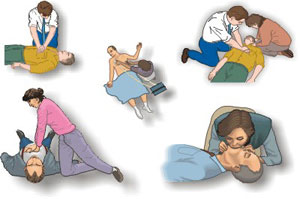
Being prepared for any type of emergency should become a virtue for everyone. This is because emergency response is not always conveniently close by. The worst thing about such situations is that they often sneak up on you unexpectedly. More often than not, once we are faced with a life or death situation, we only have ourselves to rely on. However, it is of paramount importance to remember that keeping calm is the best thing you can do. Keeping a level head and avoiding panic will let you better respond to emergency situations.
It cannot be stressed enough how crucial a basic emergency first aid training can be. These skills can come in handy in any number of situations. The following article presents one of the most basic life-saving emergency procedures. It is so simple that anyone can learn to do them in no time at all. However, it still comes highly recommended that everyone receives some form of training for these two techniques as they are perhaps the most useful.
[note color=”#55abcb”]Performing CPR[/note]
Receiving training for CPR (Cardiopulmonary Resuscitation) is one of the first things you should do if you want to be ready for emergency situations. While deceptively easy, it is certainly invaluable in times of emergency. Find for the nearest first aid and CPR training locations in your place and enroll.
This emergency technique is divided into two sub-procedures: chest compressions and rescue breaths. It is simple enough to do as it only cycles between 30 chest compressions and 2 rescue breaths. Chest compressions are done by applying significant amounts of pressure on the victim’s chest.It is very important to press hard as this is the only way to do this properly. It should also be done fast, with chest compression rates no lower than 100 pumps in a minute. After this, rescue breaths are given to the victim, with each breath lasting up to 1 second.
It was designed to be applied when a victim suddenly stopped breathing as well as in situations wherein their heart has stopped functioning. It facilitates the victim’s blood flow, ensuring that sufficient amounts oxygenated blood is able to reach their brain and other vital organs. If this technique is done correctly, it can revive the victim’s heart as well as restart their breathing.
A quick response time is the central factor for this particular emergency first aid procedure. Victims have been known to die, or suffer from permanent brain injuries, within a time span of 4-8 minutes as a result of oxygen deprivation.
[note color=”#55abcb”]Taking First Aid Classes[/note]
Online articles about CPR are extremely useful for anyone who is curious about the emergency procedure. They streamline all the basic concepts so that the readers will be able to acquire a basic understanding of the whole technique. Nevertheless, online articles are by no means a viable alternative to taking actual first aid seminars.
These classes are still the best way for anyone to learn the emergency life-saving techniques. Usually, taught by experienced emergency workers, rest assured that you will have no trouble learning all about the various emergency first aid skills like the CPR training.

